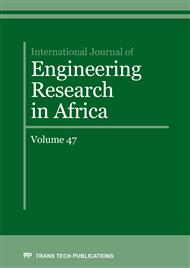[1]
B. Palacios–Munoz, Sustainability assessment of refurbishment vs. new constructions by means of LCA and durability-based estimations of buildings lifespans: A new approach, Build. Envi. 160 (2019) 106203.
DOI: 10.1016/j.buildenv.2019.106203
Google Scholar
[2]
I.Z. Bribian, A.A Uson, S. Scarpellini, Life cycle assessment in buildings: State-of-the-art and simplified LCA methodology as a complement for building certification, Build. Envi., 44 (2009) 2510-2520.
DOI: 10.1016/j.buildenv.2009.05.001
Google Scholar
[3]
G.A. Blengini; T. Di Carlo, The changing role of life cycle phases, subsystems and materials in the LCA of low energy buildings, Build. Envi. 42(6) (2010) 869-880.
DOI: 10.1016/j.enbuild.2009.12.009
Google Scholar
[4]
F. Schlegl et al., LCA of buildings in Germany: Proposal for a future benchmark based on existing databases, Energ. Build. 194 (2019) 342-350.
DOI: 10.1016/j.enbuild.2019.04.038
Google Scholar
[5]
A.A. Jensen, Life cycle assessment (LCA): a guide to approaches, experiences and information sources, Europ. Comm. (1998).
Google Scholar
[6]
J.B. Guinee et al., Life cycle assessment: past, present and future. Envi. Sci. Technol. 45 (2011) 90-96.
Google Scholar
[7]
Z. Chen, J. Tao, S.S. YU, A feature-based CAD-LCA software integration approach for eco-design, Procedia CIRP. 61 (2017) 721-726.
DOI: 10.1016/j.procir.2016.11.228
Google Scholar
[8]
A. Singh, Review of life-cycle assessment applications in building construction, J. Archit Eng. 17.1 (2010) 15-23.
Google Scholar
[9]
W. Kloepffer, Life cycle sustainability assessment of products, Int. J. Lif. Cyc. Ass. 13.2 (2008) 89.
Google Scholar
[10]
G.A. Blengini, T. Di Carlo, The changing role of life cycle phases, subsystems and materials in the LCA of low energy buildings, Energ. Build. 42.6 (2010) 869-880.
DOI: 10.1016/j.enbuild.2009.12.009
Google Scholar
[11]
ISO 14040: Environmental management: Life cycle assessment - Principles and framework, (1997).
Google Scholar
[12]
ISO 14044: Environmental Management, Life Cycle Assessment, Requirements and Guidelines, (2006).
Google Scholar
[13]
D.W. Pennington et al., Life cycle assessment Part 2: Current impact assessment practice, Envi. Int. 30.5 (2004) 721-739.
Google Scholar
[14]
D.A.L. Silva et al., Why using different Life Cycle Assessment software tools can generate different results for the same product system? A cause–effect analysis of the problem, Sustain. Prod. Consum. 20 (2019) 304-315.
DOI: 10.1016/j.spc.2019.07.005
Google Scholar
[15]
D.A.L. Silva et al., How important is the LCA software tool you choose? Comparative results from GaBi, openLCA, SimaPro and Umberto. (2017).
Google Scholar
[16]
M. Wallhagen, Environmental Assessment of Buildings and the influence on architectural design, PhD Thesis, Envi. Strate. Res.–fms. 2010, KTH.
Google Scholar
[17]
A. Estokova, M Ondova, M. Wolfova, A. Paulikova, S. Toth, Examination of Bearing Walls Regarding Their Environmental Performance, Ener. 12.2 (2019) 260.
DOI: 10.3390/en12020260
Google Scholar
[18]
M. Ondova, A. Estokova, M. Wolfova, Innovation of University education by using available online LCA methods and their role in construction sector, IOP Conf. Ser.: M. Sci. Eng. 549 (2019) 012024.
DOI: 10.1088/1757-899x/549/1/012024
Google Scholar
[19]
M.S. Gustafsson et al., Primary energy use in buildings in a Swedish perspective, Energ. Build. 130 (2016) 202-209.
Google Scholar
[20]
A.K.B. Marsono, A.T. Balasbaneh, Combinations of building construction material for residential building for the global warming mitigation for Malaysia, Constr. Build. Mater. 85 (2015) 100-108.
DOI: 10.1016/j.conbuildmat.2015.03.083
Google Scholar
[21]
V.K. Garlapati, S. Tewari, R. Ganguly, Life Cycle Assessment of First-, Second-Generation, and Microalgae Biofuels, in: Advances in Feedstock Conversion Technologies for Alternative Fuels and Bioproduct, Woodh. Pub. (2019) 355-371.
DOI: 10.1016/b978-0-12-817937-6.00019-9
Google Scholar
[22]
K.A.I. Menoufi, Life cycle analysis and life cycle impact assessment methodologies: A state of the art, Univ. Lleid. (2011).
Google Scholar
[23]
U.Y. Abeysundara, S. Babel, A. Gheewala, A matrix in life cycle perspective for selecting sustainable materials for buildings in Sri Lanka, Build. Envi. 44.5 (2009) 997-1004.
DOI: 10.1016/j.buildenv.2008.07.005
Google Scholar
[24]
M. Pohrincak, A. Estokova, S. Vilcekova, Comparison of environmental impact of building materials of three residential buildings, Poll. Perio. 6.3 (2011) 53-62.
Google Scholar
[25]
A. Pears, Practical and policy issues in analysis of embodied energy and its application. In: proceedings of embodied energy seminar: current state of play, Deakin University, (1996).
Google Scholar
[26]
A. Estokova, S. Vilcekova, M. Pohrincak, Analyzing embodied energy, global warming and acidification potentials of materials in residential buildings, Proc. Eng. 180 (2017) 1675-1683.
DOI: 10.1016/j.proeng.2017.04.330
Google Scholar
[27]
L. Perez–Lombard, J. Ortiz, CH. Pout, A review on buildings energy consumption information. Energ. Build. 40.3 (2008) 394-398.
DOI: 10.1016/j.enbuild.2007.03.007
Google Scholar
[28]
I. Yüsek, The evaluation of building materials in terms of energy efficiency, Per. Poly. – CIV. 59.1 (2015) 45-58.
Google Scholar


